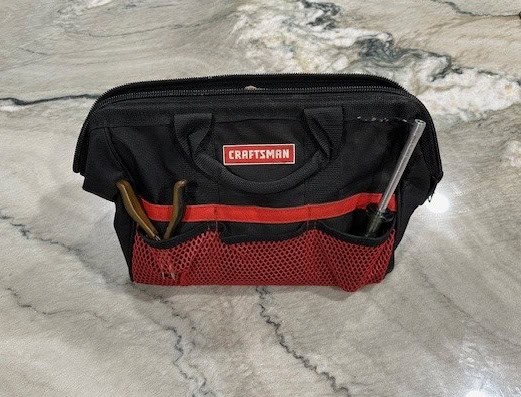A tool bag is a portable storage solution designed to hold, organize, and protect a variety of tools. Typically made from durable materials like heavy-duty canvas, nylon, or leather, tool bags come in various sizes and configurations to accommodate different toolsets. They are equipped with multiple compartments, pockets, and sometimes loops to keep tools secure and easily accessible. Tool bags are essential for both professional tradespeople and DIY enthusiasts, providing a convenient way to transport tools to job sites or around the home.
History of the Tool Bag
The tool bag has a long history, evolving alongside the development of tools themselves. In ancient times, craftsmen and tradespeople used simple pouches or satchels made from animal hides to carry their essential tools. As trade and craftsmanship advanced during the Middle Ages, these pouches became more sophisticated, often featuring compartments for specific tools. The Industrial Revolution in the 18th and 19th centuries brought about significant changes in tool design and production, necessitating the development of more specialized storage solutions. Modern tool bags, with their rugged materials and thoughtful designs, have been refined over the years to meet the demands of various trades, blending functionality with durability.
Types of Tool Bags
- Open-Top Tool Bags: Easy access to tools, often with external pockets.
- Zippered Tool Bags: Secure, enclosed space for tools, ideal for protecting against the elements.
- Rolling Tool Bags: Feature wheels and a telescoping handle for easy transport of heavy loads.
- Backpack Tool Bags: Hands-free carrying option, perfect for jobs that require mobility.
- Bucket Tool Organizers: Convert a standard 5-gallon bucket into a tool storage solution.
- Tool Pouches: Smaller, lightweight option for carrying essential tools on the go.
Tool Bag Key Features
- Durable Material: Typically made from canvas, nylon, or leather to withstand heavy use.
- Multiple Compartments: Various pockets, loops, and dividers for tool organization.
- Reinforced Handles and Straps: For comfortable carrying, even with heavy loads.
- Water-Resistant Base: Protects tools from moisture and ensures bag longevity.
- Zippers or Velcro Closures: Secure the contents of the bag.
- Padding: Offers extra protection for delicate tools and added comfort for the user.
Choosing the Right Tool Bag
Selecting the right tool bag depends on your specific needs and the type of work you do. Consider the size and weight of your tool collection, the environments in which you’ll be working, and your preferred method of transport. For example, a large, rolling tool bag is ideal for a professional electrician who needs to carry a wide range of tools, while a compact tool pouch might be better suited for a DIY enthusiast working on small projects around the house. Durability and comfort are key factors, so look for bags with reinforced seams, padded straps, and sturdy zippers.
Tool Bag Recommendations
- AWP 15 Inch Tool Bag with Apex Handle Design
- 3 Pack Premium Tool Pouch Zipper Bag with Internal Pockets
Proper Use and Techniques
Using a tool bag properly involves organizing your tools efficiently and distributing the weight evenly to prevent strain. Start by placing the heaviest tools at the bottom or in the center of the bag to maintain balance. Utilize pockets and compartments for smaller tools and accessories, keeping frequently used items within easy reach. Avoid overloading the bag, as this can cause damage to the bag and make it difficult to carry. Regularly check that all tools are securely fastened, especially if the bag is being transported to different job sites.
Maintenance and Care
Maintaining your tool bag ensures it lasts for years and continues to protect your tools. Clean the bag regularly by wiping it down with a damp cloth and mild detergent, paying special attention to zippers and closures. For leather tool bags, apply a leather conditioner to keep the material supple and prevent cracking. Inspect the bag for signs of wear and tear, such as fraying seams or broken zippers, and repair or replace components as needed. Store the tool bag in a cool, dry place when not in use to prevent mold and mildew from forming.
Safety Tips
Safety is paramount when using a tool bag, especially on job sites. Always ensure that your tool bag is in good condition, with no loose or damaged parts that could cause injury. Be mindful of the weight of the bag to prevent strain or injury when lifting. Use proper lifting techniques, bending at the knees rather than the waist. If the tool bag has sharp tools or objects, ensure they are properly secured and sheathed to avoid accidental cuts. Additionally, avoid placing the tool bag in high-traffic areas where it could become a tripping hazard.
Conclusion
A tool bag is an indispensable item for anyone who works with tools, offering organization, protection, and portability. Whether you’re a professional tradesperson or a DIY enthusiast, investing in the right tool bag can make your projects more efficient and your tools more accessible. By understanding the types available, choosing the right one for your needs, and following proper use and maintenance guidelines, you can ensure that your tool bag remains a reliable companion for years to come.


